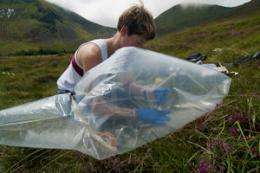Scientists make tiny new magnets from old bugs

(PhysOrg.com) -- Scientists in Manchester have found a clean and green way of making tiny magnets for high tech gadgets - using natural bacteria that have been around for millions of years.
The work by a team of geomicrobiologists from the University of Manchester paves the way for nanometer-size magnets - used in mobile phones and recording devices - to be made without the usual nasty chemicals and energy intensive methods.
Researchers studied iron-reducing bacteria that occur naturally in soils and sediments and found they can be used to create iron oxide nanoparticles with magnetic properties similar to those created through complex chemical processes.
Working with colleagues in Birmingham and Cardiff, the Manchester researchers also found a way of exercisising precise control over the size and magnetic strength of nanomagnets produced.
The high-tech particle accelerators at the Advanced Light Source at the famous Berkeley Labs near San Francisco, and the UK’s Diamond Light Source in Oxford at Harwell were used to verify findings.
Researchers added cobalt, manganese or nickel to the basic iron-based energy source used by bacteria, which resulted in the production of tiny magnets containing these elements. This greatly enhanced their useful magnetic properties.
Aside from being used in the latest gadgets, nanomagnets also have the potential to be used in drug delivery systems and cancer therapies to carefully focus and target the release of chemicals into the body.
Metal-reducing bacteria live in environments deficient in oxygen and react with oxidised metals to produce natural magnets in the ground beneath our feet.
And now the research team has developed a way of harnessing pure strains of these bacteria - which are in plentiful supply and reproduce quickly - to produce large quantities of nanomagnets at an ambient temperature.
This compares favourably to the extreme temperatures - as high as 1000 degrees Celsius - needed to create nanomagnets using current methods.
Prof Richard Patrick, Professor of Earth Science, said: “This is exciting work that raises the exciting prospect of a biologically friendly, energy-efficient method of producing nanomagnets tailored for different uses.”
A paper - ‘Harnessing the extracellular bacterial production of nanoscale cobalt ferrite with exploitable magnetic properties’ - outlining the research was published recently in the journal ACS Nano.
More information: V.S. Coker, N.D. Telling, G. van der Laan, R.A.D. Pattrick, C.I. Pearce, E. Arenholz, F. Tuna, R. Winpenny, and J.R. Lloyd, "Harnessing the extracellular bacterial production of nanoscale cobalt ferrite with exploitable magnetic properties," ACS Nano 3, 1922 (2009)
Provided by University of Manchester

















